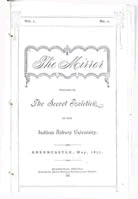|

Pages: << Back 6
7 8 9
10 11
12 13 14 Next
>>
Organized sports were slow to develop at Indiana Asbury, though
as early as 1866 a baseball team was organized which lost two games
to Wabash in November of that year and May of the next, thus inaugurating
the long athletic rivalry between the neighboring institutions.
There is no record of another engagement until 1875, when Asbury
turned the tables, winning by a score of 39-9. By 1879 an informal
program of intramurals had begun, with baseball contests between
classes and later between fraternities.
On May 20, 1880, the first intercollegiate football
game was played in Greencastle between Asbury and Butler University,
won by the latter by a margin of four touchdowns. In the afternoon
a baseball game between the two institutions ended in a forfeit
to Asbury by the score of 9-1 when the Butler team walked off the
field for some reason after the sixth inning. In the spring of 1884
Asbury played two baseball games with Indiana University, both won
by the state institution, and lost another football
match to Butler in Indianapolis.
The first "field day" took place on Washington's birthday
in 1881, when the military department sponsored a two-mile go-as-you-please
race, a wrestling match, a dumb-bell contest, a 200-yard dash, a
standing and running broad jump, a wheelbarrow race, and a tug-of-war
between classes (won by the freshmen), as well as a ladies walking
match. In the meantime the gymnasium in West College was equipped
for use by students on a fee basis under the direction of the military
department. The 1881-82 catalogue listed its equipment, which included
horizontal and parallel bars, a rowing machine, a single and double
trapeze, along with boxing gloves, fencing foils, and Indian clubs.
The beginning of the decline in importance of the student literary
societies may be dated from the late '70s, when their intellectual
and forensic aspect yielded to a more social orientation, perhaps
partly as a result of the introduction of coeducation. After 1877
they sponsored three evenings a term which were devoted to music
and socializing, with only "short" speeches. Regular meetings
were often marked by violent political squabbles between the various
fraternities and between fraternity
members and "barbs," as non-fraternity men and women were
labeled. The faculty finally ordered the selection of a sergeant-at-arms
to keep order, even in the all-female Philomathean Society.

____________________________________________________
The Mirror was the forerunner of the yearbook. Some 72
pages in length, it was published in 1877 by five of the seven
fraternities and the two sororities and sold for 30¢.
It preceded the Mirage by a decade.
____________________________________________________
A
major factor in the decline of the literary
societies was undoubtedly the growth of the social fraternities.
By 1884 slightly more than three-fourths of the male students were
members of the seven fraternities
on campus: Beta Theta Pi (1845), Phi Gamma Delta (1856), Sigma Chi
(1859), Phi Kappa Psi (1865), Delta Kappa Epsilon (1866), Phi Delta
Theta (1868), and Delta Tau Delta (1871). A smaller proportion of
women belonged to the two sororities, Kappa Alpha Theta (1870) and
Kappa Kappa Gamma (1875). There was also a small association of
"organized barbs." The fraternities rented meeting halls,
usually second or third floors of downtown Greencastle buildings,
and furnished them like the literary societies,
quite luxurious for that day. Here they had regular meetings, social
activities, receptions. On Commencement they would have reunions
and special meetings.
Historian George Manhart, in his DePauw Through the Years, reports
a Delta Kappa Epsilon activity in 1883.
About 6:30 a.m. the boys with the ladies started a "jolly
drive" of about two and a half hours to Raccoon, a distance
of sixteen miles. The morning was given to swings, croquet, and
exploration of the surrounding country. Food was served by a Greencastle
caterer, and then followed "cool rest in the leafy shades ...
strolls along the `forest aisles"' and finally the "trip
home more delightful, if possible, than the ride out" enjoying
a royal sunset, and reaching Greencastle "long after the moon
had risen, lending a tinge of romance to the scene.
The literary societies, however, played
a significant role in some of the first student
publications. During 1847-48 the Platonean and Philologian appeared
as a joint enterprise of the literary societies.
In 1873 the two male societies were joined by the Philomathean in
reviving the Asbury Review, which had begun publication in 1866
but ceased to exist two years later, after a confrontation with
the faculty and administration over letters and editorials criticizing
the introduction of coeducation and other matters. It halted publication
again in 1876.
Then in September 1878, the university sponsored a new journal,
the Asbury Monthly, with Professor Thomas J. Bassett as editorial
director of a staff of five students. The next year the three literary
societies took over its management, but by 1880 Philomathean
dropped out, apparently because of dissatisfaction with the minor
role assigned its members by the male editors. Despite this unfortunate
disagreement and continuing conflict with the faculty and administration,
the Asbury Monthly was relatively successful and continued publication
longer than any previous paper.
Besides such legitimate campus publications, from time to time rather
scurrilous sheets were put out by students, usually under the title
Bogus. The first effort at producing a yearbook was made by five
of the fraternities which issued
the Mirror in 1877. It featured names of fraternity members, faculty,
students, and trustees as well as information about the literary
societies, athletics, and other campus activities. Not until
1884 was another Mirror issued, this time as a private enterprise
of two members of the senior class, complete with commercial advertisements.
Neither contained photographs, the main staple of such publications
in a later era.
Back
to Top
Pages: << Back 6
7 8 9
10 11
12 13 14
15 Next
>>
|

